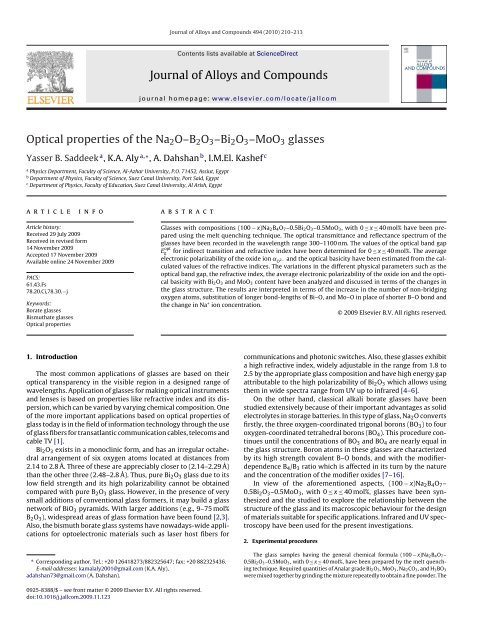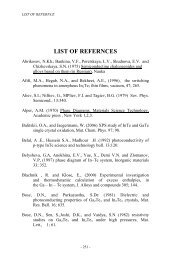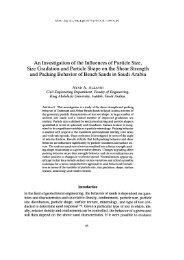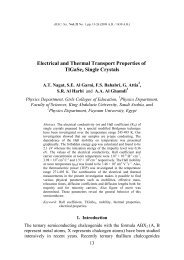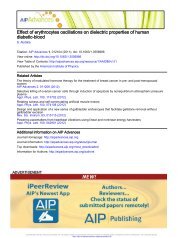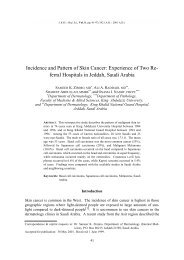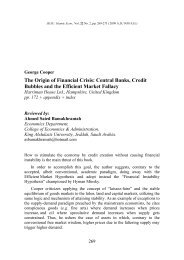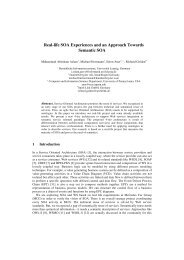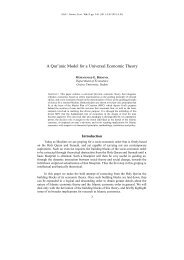Optical properties of the Na2Oââ¬âB2O3ââ¬âBi2O3ââ¬âMoO3 glasses
Optical properties of the Na2Oââ¬âB2O3ââ¬âBi2O3ââ¬âMoO3 glasses
Optical properties of the Na2Oââ¬âB2O3ââ¬âBi2O3ââ¬âMoO3 glasses
You also want an ePaper? Increase the reach of your titles
YUMPU automatically turns print PDFs into web optimized ePapers that Google loves.
Journal <strong>of</strong> Alloys and Compounds 494 (2010) 210–213<br />
Contents lists available at ScienceDirect<br />
Journal <strong>of</strong> Alloys and Compounds<br />
journal homepage: www.elsevier.com/locate/jallcom<br />
<strong>Optical</strong> <strong>properties</strong> <strong>of</strong> <strong>the</strong> Na 2 O–B 2 O 3 –Bi 2 O 3 –MoO 3 <strong>glasses</strong><br />
Yasser B. Saddeek a , K.A. Aly a,∗ , A. Dahshan b , I.M.El. Kashef c<br />
a Physics Department, Faculty <strong>of</strong> Science, Al-Azhar University, P.O. 71452, Assiut, Egypt<br />
b Department <strong>of</strong> Physics, Faculty <strong>of</strong> Science, Suez Canal University, Port Said, Egypt<br />
c Department <strong>of</strong> Physics, Faculty <strong>of</strong> Education, Suez Canal University, Al Arish, Egypt<br />
article<br />
info<br />
abstract<br />
Article history:<br />
Received 29 July 2009<br />
Received in revised form<br />
14 November 2009<br />
Accepted 17 November 2009<br />
Available online 24 November 2009<br />
PACS:<br />
61.43.Fs<br />
78.20.Ci,78.30.−j<br />
Keywords:<br />
Borate <strong>glasses</strong><br />
Bismuthate <strong>glasses</strong><br />
<strong>Optical</strong> <strong>properties</strong><br />
Glasses with compositions (100 − x)Na 2 B 4 O 7 –0.5Bi 2 O 3 –0.5MoO 3 , with 0 ≤ x ≤ 40 mol% have been prepared<br />
using <strong>the</strong> melt quenching technique. The optical transmittance and reflectance spectrum <strong>of</strong> <strong>the</strong><br />
<strong>glasses</strong> have been recorded in <strong>the</strong> wavelength range 300–1100 nm. The values <strong>of</strong> <strong>the</strong> optical band gap<br />
E opt<br />
g<br />
for indirect transition and refractive index have been determined for 0 ≤ x ≤ 40 mol%. The average<br />
electronic polarizability <strong>of</strong> <strong>the</strong> oxide ion ˛O2− and <strong>the</strong> optical basicity have been estimated from <strong>the</strong> calculated<br />
values <strong>of</strong> <strong>the</strong> refractive indices. The variations in <strong>the</strong> different physical parameters such as <strong>the</strong><br />
optical band gap, <strong>the</strong> refractive index, <strong>the</strong> average electronic polarizability <strong>of</strong> <strong>the</strong> oxide ion and <strong>the</strong> optical<br />
basicity with Bi 2 O 3 and MoO 3 content have been analyzed and discussed in terms <strong>of</strong> <strong>the</strong> changes in<br />
<strong>the</strong> glass structure. The results are interpreted in terms <strong>of</strong> <strong>the</strong> increase in <strong>the</strong> number <strong>of</strong> non-bridging<br />
oxygen atoms, substitution <strong>of</strong> longer bond-lengths <strong>of</strong> Bi–O, and Mo–O in place <strong>of</strong> shorter B–O bond and<br />
<strong>the</strong> change in Na + ion concentration.<br />
© 2009 Elsevier B.V. All rights reserved.<br />
1. Introduction<br />
The most common applications <strong>of</strong> <strong>glasses</strong> are based on <strong>the</strong>ir<br />
optical transparency in <strong>the</strong> visible region in a designed range <strong>of</strong><br />
wavelengths. Application <strong>of</strong> <strong>glasses</strong> for making optical instruments<br />
and lenses is based on <strong>properties</strong> like refractive index and its dispersion,<br />
which can be varied by varying chemical composition. One<br />
<strong>of</strong> <strong>the</strong> more important applications based on optical <strong>properties</strong> <strong>of</strong><br />
glass today is in <strong>the</strong> field <strong>of</strong> information technology through <strong>the</strong> use<br />
<strong>of</strong> glass fibers for transatlantic communication cables, telecoms and<br />
cable TV [1].<br />
Bi 2 O 3 exists in a monoclinic form, and has an irregular octahedral<br />
arrangement <strong>of</strong> six oxygen atoms located at distances from<br />
2.14 to 2.8 Å. Three <strong>of</strong> <strong>the</strong>se are appreciably closer to (2.14–2.29 Å)<br />
than <strong>the</strong> o<strong>the</strong>r three (2.48–2.8 Å). Thus, pure Bi 2 O 3 glass due to its<br />
low field strength and its high polarizability cannot be obtained<br />
compared with pure B 2 O 3 glass. However, in <strong>the</strong> presence <strong>of</strong> very<br />
small additions <strong>of</strong> conventional glass formers, it may build a glass<br />
network <strong>of</strong> BiO 3 pyramids. With larger additions (e.g., 9–75 mol%<br />
B 2 O 3 ), widespread areas <strong>of</strong> glass formation have been found [2,3].<br />
Also, <strong>the</strong> bismuth borate glass systems have nowadays-wide applications<br />
for optoelectronic materials such as laser host fibers for<br />
∗ Corresponding author. Tel.: +20 126418273/882325647; fax: +20 882325436.<br />
E-mail addresses: kamalaly2001@gmail.com (K.A. Aly),<br />
adahshan73@gmail.com (A. Dahshan).<br />
communications and photonic switches. Also, <strong>the</strong>se <strong>glasses</strong> exhibit<br />
a high refractive index, widely adjustable in <strong>the</strong> range from 1.8 to<br />
2.5 by <strong>the</strong> appropriate glass composition and have high energy gap<br />
attributable to <strong>the</strong> high polarizability <strong>of</strong> Bi 2 O 3 which allows using<br />
<strong>the</strong>m in wide spectra range from UV up to infrared [4–6].<br />
On <strong>the</strong> o<strong>the</strong>r hand, classical alkali borate <strong>glasses</strong> have been<br />
studied extensively because <strong>of</strong> <strong>the</strong>ir important advantages as solid<br />
electrolytes in storage batteries. In this type <strong>of</strong> glass, Na 2 O converts<br />
firstly, <strong>the</strong> three oxygen-coordinated trigonal borons (BO 3 ) to four<br />
oxygen-coordinated tetrahedral borons (BO 4 ). This procedure continues<br />
until <strong>the</strong> concentrations <strong>of</strong> BO 3 and BO 4 are nearly equal in<br />
<strong>the</strong> glass structure. Boron atoms in <strong>the</strong>se <strong>glasses</strong> are characterized<br />
by its high strength covalent B–O bonds, and with <strong>the</strong> modifierdependence<br />
B 4 /B 3 ratio which is affected in its turn by <strong>the</strong> nature<br />
and <strong>the</strong> concentration <strong>of</strong> <strong>the</strong> modifier oxides [7–16].<br />
In view <strong>of</strong> <strong>the</strong> aforementioned aspects, (100 − x)Na 2 B 4 O 7 –<br />
0.5Bi 2 O 3 –0.5MoO 3 , with 0 ≤ x ≤ 40 mol%, <strong>glasses</strong> have been syn<strong>the</strong>sized<br />
and <strong>the</strong> studied to explore <strong>the</strong> relationship between <strong>the</strong><br />
structure <strong>of</strong> <strong>the</strong> glass and its macroscopic behaviour for <strong>the</strong> design<br />
<strong>of</strong> materials suitable for specific applications. Infrared and UV spectroscopy<br />
have been used for <strong>the</strong> present investigations.<br />
2. Experimental procedures<br />
The glass samples having <strong>the</strong> general chemical formula (100 − x)Na 2B 4O 7–<br />
0.5Bi 2O 3–0.5MoO 3, with 0 ≤ x ≤ 40 mol%, have been prepared by <strong>the</strong> melt quenching<br />
technique. Required quantities <strong>of</strong> Analar grade Bi 2O 3,MoO 3,Na 2CO 3, and H 3BO 3<br />
were mixed toge<strong>the</strong>r by grinding <strong>the</strong> mixture repeatedly to obtain a fine powder. The<br />
0925-8388/$ – see front matter © 2009 Elsevier B.V. All rights reserved.<br />
doi:10.1016/j.jallcom.2009.11.123
Y.B. Saddeek et al. / Journal <strong>of</strong> Alloys and Compounds 494 (2010) 210–213 211<br />
Fig. 1. X-ray diffraction patterns <strong>of</strong> <strong>the</strong> glass system (100 − x)Na 2B 4O 7–<br />
0.5Bi 2O 3–0.5MoO 3, with 0 ≤ x ≤ 40 mol%.<br />
Fig. 3. Tauc’s plots for <strong>the</strong> glass system (100 − x)Na 2B 4O 7–0.5Bi 2O 3–0.5MoO 3, with<br />
0 ≤ x ≤ 40 mol%.<br />
is given by<br />
˛h = A 0 (h − E opt<br />
g ) p (2)<br />
Fig. 2. Spectral behaviour <strong>of</strong> (a) transmittance and (b) reflectance <strong>of</strong> <strong>the</strong> glass system<br />
(100 − x)Na 2B 4O 7–0.5Bi 2O 3–0.5MoO 3, with 0 ≤ x ≤ 40 mol%.<br />
mixture was melted in a Porcelain crucible in an electrically heated furnace under<br />
ordinary atmospheric conditions at temperature about 1373 K for 2 h to homogenize<br />
<strong>the</strong> melt. The obtained glass samples were quenched into preheated stainless-steel<br />
mold preheated at a temperature <strong>of</strong> about 573 K for 2 h to remove any internal<br />
stresses. The samples were <strong>the</strong>n grounded and optically polished to have suitable<br />
dimensions (2 cm × 1cm× 0.15 cm) for <strong>the</strong> present optical measurements.<br />
X-ray measurements were performed to check <strong>the</strong> non-crystallinity <strong>of</strong> <strong>the</strong> glass<br />
samples using a Philips X-ray diffractometer PW/1710 with Ni-filtered, Cu K radiation<br />
( = 1.542 Å) powered at 40 kV and 30 mA. The XRD patterns <strong>of</strong> <strong>the</strong> <strong>glasses</strong> as<br />
shown in Fig. 1 did not reveal discrete or any sharp peaks, but <strong>the</strong> characteristic<br />
broad humps <strong>of</strong> <strong>the</strong> amorphous materials.<br />
The transmittance (T), and <strong>the</strong> reflectance (R) optical spectra <strong>of</strong> <strong>the</strong> <strong>glasses</strong><br />
(Fig. 2) were recorded at room temperature in <strong>the</strong> wavelength range 300–1100 nm<br />
using a computerized double beam spectrophotometer, type SHIMADZU UV-2100.<br />
where ˛0 is an energy-independent constant (band edge steepness<br />
parameter in Tauc’s picture [18]). For amorphous materials indirect<br />
transitions are valid according to Tauc [18], i.e. power part p = 2; so,<br />
<strong>the</strong> values <strong>of</strong> indirect optical band-gap energy (E opt<br />
g ) can be obtained<br />
from Eq. (2) by extrapolating <strong>the</strong> absorption coefficient to zero<br />
absorption in <strong>the</strong> (˛h) 1/2 –h plot as shown in Fig. 3. The respective<br />
values <strong>of</strong> E opt<br />
g are obtained by extrapolating to (˛h) 1/2 = 0 for <strong>the</strong><br />
indirect transitions [18,19]. The compositional dependence <strong>of</strong> E opt<br />
g<br />
shows a decrease trend as <strong>the</strong> Bi 2 O 3 and MoO 3 content as shown<br />
in Fig. 4. The decreasing values <strong>of</strong> E opt<br />
g can be understood in terms<br />
<strong>of</strong> <strong>the</strong> structural changes that are taking place in <strong>the</strong> studied glass<br />
system. According to <strong>the</strong> IR analysis [20], <strong>the</strong> stoichiometry <strong>of</strong> <strong>the</strong><br />
sodium diborate glass, by considering <strong>the</strong> association <strong>of</strong> Na 2 O with<br />
both MoO 3 and B 2 O 3 . Therefore, <strong>the</strong> BO 4 units will be destroyed and<br />
is converted into asymmetric BO 3 units with non-bridging oxygens.<br />
Also, <strong>the</strong> structure <strong>of</strong> <strong>the</strong> investigated <strong>glasses</strong> has distorted [BiO 6 ]<br />
octahedral units which shift <strong>the</strong> structural unit [BO 3 ] to lower wave<br />
numbers, and shifted <strong>the</strong> band <strong>of</strong> [BO 4 ] unit to higher wave number.<br />
This behaviour can be explained as to be due to <strong>the</strong> formation<br />
<strong>of</strong> new bridging bond <strong>of</strong> Bi–O–B. This new bond is formed due to <strong>the</strong><br />
inducement <strong>of</strong> <strong>the</strong> electrostatic field <strong>of</strong> <strong>the</strong> strongly polarizing Bi 3+<br />
ions. The stretching force constant <strong>of</strong> this bond tends to decrease,<br />
since <strong>the</strong> stretching force constant <strong>of</strong> Bi–O bonding is lower than<br />
that <strong>of</strong> <strong>the</strong> B–O bonding. Accordingly, <strong>the</strong> bond-length <strong>of</strong> Bi–O<br />
3. Results and discussion<br />
3.1. Determination <strong>of</strong> optical band gap<br />
The optical absorption coefficient, ˛, <strong>of</strong> a material can be evaluated<br />
from <strong>the</strong> optical transmittance, reflectance and <strong>the</strong> thickness<br />
<strong>of</strong> <strong>the</strong> sample (d) using <strong>the</strong> relation:<br />
˛ = 1 d ln 1 − R<br />
T<br />
(1)<br />
The absorption coefficient ˛() as a function <strong>of</strong> photon energy (h)<br />
for direct and indirect optical transitions, according to Pankove [17]<br />
Fig. 4. Dependence <strong>of</strong> <strong>the</strong> indirect optical band gaps <strong>of</strong> <strong>the</strong> glass system<br />
(100 − x)Na 2B 4O 7–0.5Bi 2O 3–0.5MoO 3, with 0 ≤ x ≤ 40 mol% on <strong>the</strong> parameter x.
212 Y.B. Saddeek et al. / Journal <strong>of</strong> Alloys and Compounds 494 (2010) 210–213<br />
dependence <strong>of</strong> <strong>the</strong> refractive indices <strong>of</strong> <strong>the</strong> studied <strong>glasses</strong> can be<br />
explained as follows. According to <strong>the</strong> Lorentz–Lorenz equation,<br />
<strong>the</strong> density <strong>of</strong> <strong>the</strong> material affects <strong>the</strong> refractive index in a direct<br />
proportion. Also, <strong>the</strong>re are some factors influence on <strong>the</strong> refractive<br />
index such as; <strong>the</strong> coordination number, Z, <strong>of</strong> <strong>the</strong> studied <strong>glasses</strong><br />
can explain its increase as <strong>the</strong> introducing <strong>of</strong> <strong>the</strong> structural units<br />
BiO 6 , and MoO 6 as stated previously, on <strong>the</strong> expense <strong>of</strong> ei<strong>the</strong>r BO 4<br />
or BO 3 will increase <strong>the</strong> coordination number <strong>of</strong> <strong>the</strong> <strong>glasses</strong>, and<br />
creating more NBOs, as noted in IR spectra [20]. This in turn leads<br />
to an increase in <strong>the</strong> average coordination number <strong>of</strong> <strong>the</strong> studied<br />
<strong>glasses</strong>, with respect to <strong>the</strong> base glass sample, which is increasing<br />
<strong>the</strong>ir index values. Also, <strong>the</strong> creation <strong>of</strong> NBOs creates more ionic<br />
bonds, which manifest <strong>the</strong>mselves in a larger polarizability over<br />
<strong>the</strong> mostly covalent bonds <strong>of</strong> bridging oxygen providing a higher<br />
index value.<br />
Fig. 5. The refractive index <strong>of</strong> (100 − x)Na 2B 4O 7–0.5Bi 2O 3–0.5MoO 3, with<br />
0 ≤ x ≤ 40 mol% <strong>glasses</strong> as a function <strong>of</strong> wavelength in a wavelength range from 400<br />
to 1100 nm.<br />
bonding increases, which in turn expand <strong>the</strong> glass network and<br />
replaces B–O linkage by <strong>the</strong> weaker Bi–O and Mo–O linkages. Thus,<br />
<strong>the</strong> available oxygen environment around <strong>the</strong> bismuth cations will<br />
increase, and this will decrease <strong>the</strong> values <strong>of</strong> E opt<br />
g .<br />
3.2. Determination <strong>of</strong> <strong>the</strong> refractive index<br />
According to <strong>the</strong> <strong>the</strong>ory <strong>of</strong> reflectivity <strong>of</strong> light, <strong>the</strong> refractive<br />
index (n) as a function <strong>of</strong> <strong>the</strong> reflectance (R), and <strong>the</strong> extinction<br />
coefficient (k) is given by <strong>the</strong> quadratic equation:<br />
R = (1 − n)2 + k 2<br />
(1 + n) 2 (3)<br />
+ k 2<br />
The extinction coefficient can be determined from <strong>the</strong> wavelength<br />
() and <strong>the</strong> calculated values <strong>of</strong> ˛ according to <strong>the</strong> relation:<br />
˛ = 4k<br />
(4)<br />
<br />
The refractive index can be well described by a modified Sellmeier<br />
dispersion relation (solid lines in Fig. 5):<br />
n() = A − B + C 2 − D 3 + E 4 (5)<br />
where A, B, C, D and E are <strong>the</strong> Sellmeier coefficients are averaged<br />
and given in Table 1 for all <strong>glasses</strong>.<br />
As shown in Eq. (5), <strong>the</strong> changes in <strong>the</strong> refractive index are<br />
affected by wavelength changes. Fig. 5 shows <strong>the</strong> plots <strong>of</strong> <strong>the</strong> refractive<br />
index as a function <strong>of</strong> <strong>the</strong> wavelength for <strong>the</strong> studied <strong>glasses</strong>.<br />
From this figure <strong>the</strong> refractive decrease with increase <strong>the</strong> wavelength<br />
and increase as <strong>the</strong> Bi 2 O 3 and MoO 3 content increases in<br />
<strong>the</strong> wavelength range <strong>of</strong> 200–2000 nm. Thus, <strong>the</strong> compositional<br />
3.3. Polarizability and optical basicity <strong>of</strong> <strong>the</strong> <strong>glasses</strong><br />
The average electronic polarizability <strong>of</strong> ions and <strong>the</strong> optical<br />
basicity are considered to be from <strong>the</strong> most important <strong>properties</strong> <strong>of</strong><br />
<strong>the</strong> materials, which is closely related to <strong>the</strong>ir applicability in <strong>the</strong><br />
field <strong>of</strong> optics and electronics. The optical basicity proposed was<br />
used as a measurement <strong>of</strong> acid–base <strong>properties</strong> <strong>of</strong> <strong>the</strong> oxide <strong>glasses</strong>,<br />
and is expressed in terms <strong>of</strong> <strong>the</strong> electron density carried by oxygen.<br />
It was found that, optical non-linearity is caused by <strong>the</strong> electronic<br />
polarization <strong>of</strong> a material upon its exposure to intense light beams,<br />
so, <strong>the</strong> non-linear response <strong>of</strong> <strong>the</strong> material is governed by <strong>the</strong> electronic<br />
polarizability. For this purpose, materials with higher optical<br />
non-linearity have to be found or designed on <strong>the</strong> basis <strong>of</strong> <strong>the</strong> correlation<br />
between <strong>the</strong> optical non-linearity and with some o<strong>the</strong>r easily<br />
understandable and accessible electronic <strong>properties</strong> [21–24].<br />
For isotropic substance such as <strong>glasses</strong>, <strong>the</strong> average molar refraction<br />
(R m ) was given by <strong>the</strong> Lorentz–Lorenz equation:<br />
[ ] [ ]<br />
n 2 − 1 M n 2 R m =<br />
n 2 + 2 = − 1<br />
n 2 V m (6)<br />
+ 2<br />
where <strong>the</strong> quantity (n 2 − 1)/(n 2 + 2) is called <strong>the</strong> reflection loss<br />
[24,25]. The molar refraction is related to <strong>the</strong> structure <strong>of</strong> <strong>the</strong><br />
glass and it is proportional to <strong>the</strong> molar electronic polarizability<br />
<strong>of</strong> <strong>the</strong> material (˛m) (in ×10 −24 cm 3 ) through <strong>the</strong> following<br />
Clasius–Mosotti relation:<br />
( 3<br />
)<br />
˛m = R m (7)<br />
4N<br />
where N is Avogadro’s number. For various ternary oxide <strong>glasses</strong><br />
with <strong>the</strong> general formula y 1 A p O q –y 2 B r O s –y 3 C n O m , where y’s<br />
denote <strong>the</strong> molar fraction <strong>of</strong> each oxide, <strong>the</strong> electronic polarizability<br />
<strong>of</strong> oxide ion can be calculated on <strong>the</strong> basis <strong>of</strong> refractive indices<br />
using <strong>the</strong> following equation:<br />
[ ∑ ]<br />
(Vm ˛O2−(n) /2.52)((n 2 − 1)/(n 2 + 2)) − ˛cat<br />
=<br />
(8)<br />
N O<br />
2−<br />
Table 1<br />
∑<br />
The chemical composition, <strong>the</strong> refractive index parameters, <strong>the</strong> molar cation polarizability ˛cat and <strong>the</strong> number <strong>of</strong> oxide ions in <strong>the</strong> chemical formula (N O 2− ).<br />
∑<br />
Composition (mol%)<br />
Refractive index parameters<br />
˛cat<br />
N O 2−<br />
A B C (×10 6 ) D (×10 9 ) E (×10 11 )<br />
0 2.59 2203.46 4.19 2.64 5.72 0.06 2.34<br />
5 2.60 2145.27 4.35 2.84 6.41 0.14 2.37<br />
10 2.99 3627.31 6.72 4.36 9.86 0.21 2.41<br />
15 3.33 4815.91 8.58 5.50 12.36 0.29 2.44<br />
20 3.10 3698.12 7.37 5.04 12.1 0.37 2.47<br />
25 2.48 1232.81 3.96 3.08 8.15 0.44 2.51<br />
30 2.87 2802.81 7.24 5.74 16.01 0.52 2.54<br />
35 2.38 737.817 3.59 3.09 8.96 0.60 2.57<br />
40 3.61 6072.79 12.9 9.80 26.59 0.67 2.60
Y.B. Saddeek et al. / Journal <strong>of</strong> Alloys and Compounds 494 (2010) 210–213 213<br />
A = 1.67<br />
(<br />
1 − 1<br />
˛O2−<br />
)<br />
(9)<br />
Fig. 6. The oxide ion polarizability ˛O2− <strong>of</strong> (100 − x)Na 2B 4O 7–0.5Bi 2O 3–0.5MoO 3,<br />
with 0 ≤ x ≤ 40 mol% <strong>glasses</strong> as a function <strong>of</strong> wavelength in a wavelength range from<br />
400 to 1100 nm.<br />
The A values were estimated according to Eq. (8). Fig. 7 shows a<br />
plot <strong>of</strong> optical basicity versus <strong>the</strong> wavelength for different glassy<br />
compositions. According to Fig. 7, <strong>the</strong> values <strong>of</strong> A decrease with an<br />
increase in <strong>the</strong> wavelength, and increase with an increase in <strong>the</strong><br />
Bi 2 O 3 and MoO 3 content (at any value <strong>of</strong> <strong>the</strong> wavelength). Zhao et<br />
al. [28] reported that B 2 O 3 is a strong acidic oxide with low optical<br />
basicity (0.42), while Bi 2 O 3 is an oxide with a significant basicity<br />
(1.19). The increased optical basicity <strong>of</strong> <strong>the</strong> <strong>glasses</strong> with large Bi 2 O 3<br />
and MoO 3 content indicates that <strong>the</strong> acidic oxide <strong>of</strong> Bi 2 O 3 has a<br />
significant effect. The low optical basicity means a reduced ability<br />
<strong>of</strong> oxide ions to transfer electrons to <strong>the</strong> surrounding cations. On<br />
<strong>the</strong> o<strong>the</strong>r hand, borate <strong>glasses</strong> with a large amount <strong>of</strong> Bi 2 O 3 content<br />
possess high optical basicity. High optical basicity means low<br />
electron donor ability <strong>of</strong> <strong>the</strong> oxide ions.<br />
4. Conclusions<br />
Increasing <strong>the</strong> Bi 2 O 3 and MoO 3 content on <strong>the</strong> expense <strong>of</strong><br />
Na 2 B 4 O 7 in <strong>the</strong> studied glass system, reveals some remarkable features;<br />
as <strong>the</strong> Bi 2 O 3 and MoO 3 content increase, more NBOs were<br />
created and <strong>the</strong> bond-length <strong>of</strong> <strong>the</strong> borate structural units increase<br />
which in its turn increase <strong>the</strong> refractive indices, <strong>the</strong> polarizability,<br />
and <strong>the</strong> optical basicity <strong>of</strong> <strong>the</strong> studied <strong>glasses</strong>. Also, <strong>the</strong> observed<br />
decrease in <strong>the</strong> optical band gap was related to <strong>the</strong> weaker bond<br />
strength <strong>of</strong> <strong>the</strong> Bi–O compared with that <strong>of</strong> B–O.<br />
Acknowledgements<br />
The authors thank Dr. Shaban I Hussien, Egyptian Atomic Energy<br />
Authority for his help in preparing <strong>the</strong> samples.<br />
References<br />
Fig. 7. <strong>Optical</strong> basicity for <strong>the</strong> (100 − x)Na 2B 4O 7–0.5Bi 2O 3–0.5MoO 3, with<br />
0 ≤ x ≤ 40 mol% <strong>glasses</strong>.<br />
where ˛O2−(n) <strong>the</strong> ∑ electronic polarizability <strong>of</strong> oxide ion based on<br />
refractive indices. ˛cat denotes <strong>the</strong> molar cation polarizability<br />
given by y 1 p˛A + y 2 r˛B + y 3 n˛C and N O<br />
2− denotes <strong>the</strong> number <strong>of</strong><br />
oxide ions in <strong>the</strong> chemical formula ∑ given by y 1 q + y 2 s + y 3 m. For <strong>the</strong><br />
studied <strong>glasses</strong>, <strong>the</strong> values <strong>of</strong> both ˛cat and N O<br />
2− were calculated<br />
using <strong>the</strong> values <strong>of</strong> ˛Na = 0.0291 Å 3 for Na + ions, <strong>of</strong> ˛B = 0.002 Å 3<br />
for B 3+ , ˛Bi = 1.508 Å 3 for Bi 3+ ∑ ions and <strong>of</strong> ˛Mo = 0.169 Å 3 for Mo 3+<br />
[26]. The calculated values ˛cat and N O<br />
2− are listed in Table 1.<br />
Then <strong>the</strong> electronic polarizability ˛O2−(n) for different glass compositions<br />
easily calculated by using Eq. (8) and figured as a function<br />
<strong>of</strong> wavelength as shown in Fig. 6, this figure shows that, <strong>the</strong> ˛O2− (n)<br />
decreases with <strong>the</strong> increase in <strong>the</strong> wavelength and increases with<br />
<strong>the</strong> increase in Bi 2 O 3 and MoO 3 content. It was reported that Bi 3+<br />
cation possesses a very high polarizability, which is due to its large<br />
ionic radii and small cation unit field strength. Moreover, Bi 3+ ions<br />
possess a lone pair in <strong>the</strong> valence shell. So, <strong>the</strong> increase in <strong>the</strong> average<br />
polarizability <strong>of</strong> <strong>the</strong> studied <strong>glasses</strong>, on a molar basis, can be<br />
attributed to <strong>the</strong> replacement <strong>of</strong> a less polarizable boron oxide by<br />
a highly polarizable oxides [27,28].<br />
An alternative approach for <strong>the</strong> calculation <strong>of</strong> <strong>the</strong> optical basicity<br />
is <strong>the</strong> determination <strong>of</strong> <strong>the</strong> state <strong>of</strong> polarization <strong>of</strong> oxide ions in a<br />
glass matrix on <strong>the</strong> basis <strong>of</strong> refraction data. Duffy [21,22,29] has<br />
established <strong>the</strong> following correlation:<br />
[1] K. Rao, Structural Chemistry <strong>of</strong> Glasses, Elsevier, North Holland, 2002.<br />
[2] A. Wells, Structural Inorganic Chemistry, 4th ed., Clarendon Press, Oxford, 1975.<br />
[3] W. Vogel, Chemistry <strong>of</strong> Glass, American Ceramic Society, Westerville, OH, 1985.<br />
[4] G. Sharma, K. Thind, Monika, H. Singh, Manupriya, L. Gerward, Phys. Status<br />
Solidi (A) 204 (2007) 591.<br />
[5] I. Oprea, H. Hesse, K. Betzler, Phys. Status Solidi (B) 242 (2005) R109.<br />
[6] I. Kityk, A. Majchrowski, Opt. Mater. 25 (2004) 33.<br />
[7] M. Kodama, T. Matsushita, S. Kojima, Jpn. J. Appl. Phys. 34 (1995) 2570.<br />
[8] M. Shibata, C. Sanchez, H. Patel, S. Feller, J. Stark, G. Sumcad, J. Kasper, J. Non-<br />
Cryst. Solids 85 (1986) 29.<br />
[9] S. Feller, W. Dell, P. Bray, J. Non-Cryst. Solids 51 (1982) 21.<br />
[10] K. El-Egili, A. Oraby, J. Phys.: Condens. Matter 8 (1996) 8959.<br />
[11] E.I. Kamitsos, G.D. Chryssikos, Solid State Ionics 105 (1998) 75.<br />
[12] Y. Moustafa, A. Hassan, G. El-Damrawi, N. Yevtushenko, J. Non-Cryst. Solids 194<br />
(1996) 34.<br />
[13] C. Reddy, R. Chakradhar, Mater. Res. Bull. 42 (2007) 1337.<br />
[14] V. Gowda, R. Anavekar, Ionics 10 (2004) 103.<br />
[15] B. Chowdari, Z. Rong, Solid State Ionics 90 (1996) 151.<br />
[16] M. Ganguli, K. Rao, J. Solid State Chem. 145 (1999) 65.<br />
[17] J. Pankove, <strong>Optical</strong> Processes in Semiconductors, Prentice-Hall, Englewood<br />
Cliffs, NJ, 1971.<br />
[18] J. Tauc, Amorphous and Liquid Semiconductor, Plenum Press, New York, 1974.<br />
[19] M. Nocun, W. Mozgawaa, J. Jedliński, J. Najman, J. Mol. Struct. 744–747 (2005)<br />
603.<br />
[20] Y. Saddeek, A. Abousehly, S. Hussien, J. Phys. D: Appl. Phys. 40 (2007) 4674.<br />
[21] J. Duffy, M. Ingram, J. Non-Cryst. Solids 21 (1976) 373.<br />
[22] J. Duffy, M. Ingram, J. Am. Chem. Soc. 93 (1971) 6448.<br />
[23] Y. Saddeek, E. Shaaban, E. Moustafa, H. Moustafa, Physica B 403 (2008) 2399.<br />
[24] E. Moustafa, Y. Saddeek, E. Shaaban, J. Phys. Chem. Solids 69 (2008) 2281.<br />
[25] M. Abdel-Baki, F. Abdel-Wahab, A. Radi, F. El-Diasty, J. Phys. Chem. Solids (2007)<br />
1016.<br />
[26] V. Dimitrov, S. Sakka, J. Appl. Phys. 79 (1996) 1736.<br />
[27] T. Honma, R. Sato, Y. Benino, T. Komatsu, V. Dimitrov, J. Non-Cryst. Solids 272<br />
(2000) 1.<br />
[28] X. Zhao, X. Wang, H. Lin, Z. Wang, Physica B 390 (2007) 293.<br />
[29] J. Duffy, Phys. Chem. Glasses 320 (1989) 1.


